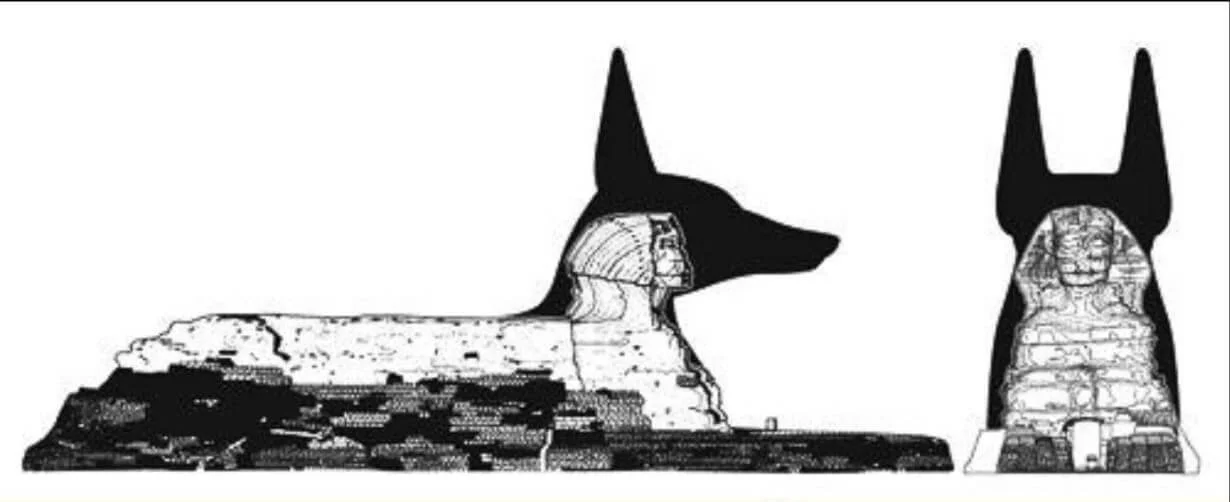The Great Sphinx of Giza, an enduring symbol of ancient Egypt, has stood sentinel over the Giza Plateau for millennia. Traditionally, it is believed to have been constructed during the reign of Pharaoh Khafre (circa 2558–2532 BC), featuring his likeness as a testament to his power and divine association. However, Robert Temple's provocative theory in his book "The Sphinx Mystery" refutes this long-held belief. Temple suggests that the Sphinx originally depicted Anubis, the jackal-headed god associated with mummification and the afterlife, and that the current human head was a later modification, possibly re-carved to resemble a Middle Kingdom Pharaoh, Amenemhet II.
Proportional Discrepancies and Symbolism
One of the central arguments supporting the Anubis theory is the proportional discrepancy between the Sphinx's head and its massive body. Critics of the traditional view point out that the head appears disproportionately small, suggesting it may have been re-carved from a larger original structure. Anubis, depicted as a jackal or a jackal-headed human, was a significant deity in ancient Egyptian religion, often associated with guarding tombs and the necropolis. Proponents argue that a monumental statue of Anubis would be fitting for the Sphinx's guardian role at the Giza Plateau, a major burial site.
Erosion Patterns and Dating
Researchers supporting the Anubis theory also examine the erosion patterns on the Sphinx's body, proposing that they indicate a much older date of construction than traditionally believed. Some suggest that the erosion could be the result of exposure to heavy rains, which would push the date of the Sphinx’s construction back to a pre-dynastic era. This idea challenges the conventional timeline that attributes the Sphinx to Khafre’s reign in the Old Kingdom. If true, it would imply a significant re-carving effort to transform an ancient Anubis statue into the current form, reflecting changes in religious or political priorities over time.
Scholarly Debate and Criticism
While intriguing, the Anubis theory remains controversial and is not widely accepted within mainstream Egyptology. Critics argue that there is no direct archaeological evidence to support the claim that the Sphinx was originally an Anubis statue. Most of the evidence presented is circumstantial and interpretative. Ancient Egyptian texts and records attribute the construction of the Sphinx to Pharaoh Khafre, and these accounts do not mention any significant alterations or re-carving. Additionally, the majority of Egyptologists maintain that the proportional issues can be explained by the limitations of the stone available and the evolution of sculpting techniques rather than by a dramatic resizing.
Scientific Validity and Mainstream Views
The scientific validity of the Anubis theory is highly contested due to the lack of robust archaeological evidence and scholarly consensus. Most mainstream scholars regard the Sphinx as an integral part of the Giza pyramid complex, constructed under the reign of Khafre without significant subsequent modifications to its original form. They emphasize that the majority of historical and archaeological data supports the traditional view, including the continuity of the Sphinx’s design with other monuments from the same period.
Conclusion
Despite the skepticism from mainstream Egyptology, the theory that the Sphinx was originally an Anubis statue presents an intriguing alternative perspective on one of Egypt's most iconic monuments. It has reignited interest and debate over the true origins and purpose of the Sphinx, reflecting the enduring mystery and allure of ancient Egyptian civilization. While the theory remains speculative without more substantial evidence, it highlights the complexities and ongoing scholarly investigations into the history of the Sphinx. Until more definitive evidence is uncovered, the traditional view of the Sphinx’s construction under Khafre will likely remain the dominant narrative in the field of Egyptology.








